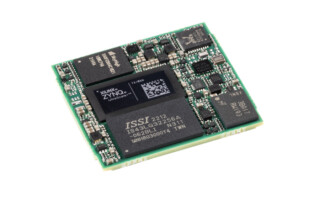To SoM or Not to SoM. An FPGA May Provide the Answer.
May 28, 2024
Story

System-on-modules, or SoMs, are small form-factor computing devices, or small computers, that combine critical components onto one PCB, typically measuring under 80 mm on a side. These devices often feature a processor, some memory and storage, and networking, audio, and video interfaces, all with varying specifications depending on your application's needs.
SoMs represent an alternative to a more discrete design approach, where the designer needn’t source all the components individually. While the module may not be exactly what the developer is looking for, in most cases, the match is very close, and certainly close enough to warrant eliminating the huge engineering effort that might otherwise be needed for a custom design.
With a SoM, you’re also leveraging the module maker’s buying power with this approach because they’re buying those discrete components in very large quantities. It’s at about the 100k level where the decisions get a little tougher. In other words, if the quantity you desire is below 100k, then it’s a no-brainer that it makes economic sense to go with the SoM. When you get above that level, the costs start to equal out, and you may have a tougher decision at hand. But by no means is it a no-brainer in the opposite direction.
Another reason to go with a SoM has to do with how difficult it can be to get high-speed transceivers (MGTs) to operate at their full speed, as high as 28.1 Gbits/s. That’s because signal Integrity at such speeds can be extremely complex to layout—that’s the differential routing with matched length and impedance— and even more difficult to verify and validate. At these speeds, deep RF expertise and equipment are necessary. Having this part completed for you with the SoC FPGA-based module generally makes the process far more streamlined.
Even More Customization
If further customization is needed beyond what’s offered by the module, the designer should be on the lookout for a SoC FPGA-based module, rather than one with a fixed CPU, resulting in improved and more efficient design capabilities. The SoC FPGA-based design further enables the ease and flexibility provided to developers, allowing the easy implementation of changes and accommodations for the design with specific functions, I/O, and design tools.

Enclustra, an engineering company focused on SoC FPGA-based system development, recently released its Pluto XZU20 SoM. Measuring 30 by 30 by 2.5 mm, approximately the size of a U.S. quarter or a 2 Euro coin, the FPGA system-on-module takes advantage of AMD’s Xilinx Zynq UltraScale+ FPGA SoC, featuring an Arm quad-core Cortex-A53, Arm dual-core Cortex-R5F, and Arm-based Mali-400MP2 GPU.
With a 16-nm FinFET+ FPGA fabric, the Pluto XZU20 supports up to 154,1000 system logic cells, and 100 user I/O consisting of 22 Arm peripherals and 78 FPGA I/Os. It also offers up to 2 Gbytes of LPDDR4 SDRAM, 64 Mbytes of QSPI flash, and 4 Gbytes of eMMC flash memory. Additionally, the computing system supports both Gigabit Ethernet and USB 3.0 interfaces.
A World-Class FPGA
With all that compute power at your disposal, you might think that the Pluto XZU20’s processor is a power hog, but that’s not the case. With its various low power modes, it consumes only about 5 to 7 W. That’s far more power efficient than a conventional CPU with similar processing capabilities. Another key advantage of the FPGA fabric is low latency, allowing the system to react in real time. Because it’s based on the popular Zynq architecture, it’s a good bet that the design team already has a high level of familiarity with the tools.

Because the Zynq FPGA is fully programmable, the Pluto XZU20 can operate in a slew of applications, ranging from industrial, vision, and health, to life sciences. More specifically, drones, surgical glasses, robots, robotic arms and drones, and portable medical devices fit the bill for high compute, low power, and small size.
The Pluto module can be soldered directly onto the carrier board, further supporting application-specific designs. But that’s not all. Enclustra offers a development board, the ST11, to further enable application development and afford more customization. The 100- by 100-mm board supports MIPI, DisplayPort, PCI Express, and Ethernet interfaces, and more. The result is that developers can easily transition from idea, to prototype, to full development board, to production in relatively few steps. Enclustra also offers software support with an onboard controller with built-in intelligence for monitoring and configuring the system in real time.
Out of the box, users get a subsystem that allows them to jumpstart their application development with minimal risk, and a short time-to-market. The Pluto XZU20 SoM is available through Enclustra’s early access program, with its official launch having occurred recently at embedded world 2024 in Nuremberg, Germany. Don’t go with just a SoM; go with an FPGA-based SoM, and get it from a company that specializes in products like these.




